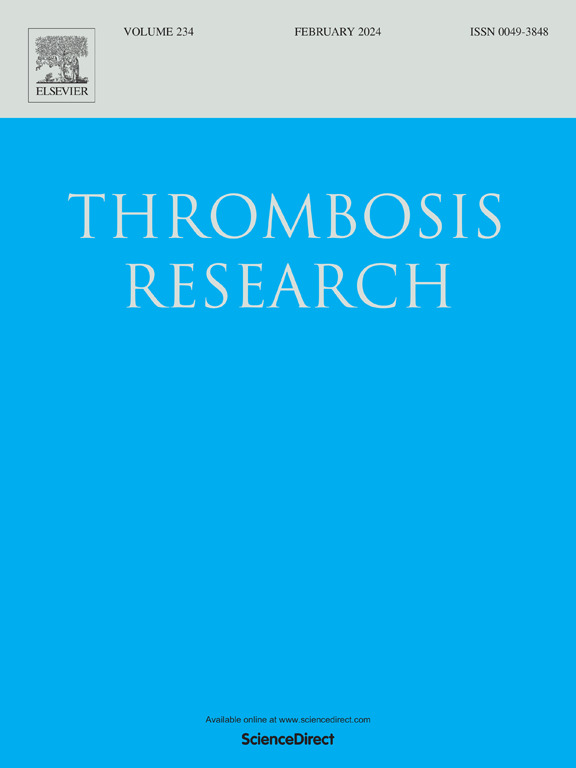转移对癌症相关孤立性远端深静脉血栓患者临床预后的影响:来自ONCO DVT研究的预先指定亚组分析
IF 3.4
3区 医学
Q1 HEMATOLOGY
引用次数: 0
摘要
背景:转移性癌症患者延长抗凝治疗的风险-收益平衡尚不清楚。目的:本预先指定的亚组分析旨在评估12个月和3个月依多沙班治疗基于癌症转移的癌症相关孤立性远端深静脉血栓形成(DVT)患者的有效性和安全性。方法ONCO DVT研究是一项随机临床试验,纳入601例癌症相关的孤立性远端DVT患者,分为转移组(N = 147)和无转移组(N = 454)。主要终点是12个月时症状性复发性静脉血栓栓塞(VTE)或VTE相关死亡,主要次要终点是12个月时大出血。结果在转移亚组(3.2% vs. 21.6%, Log-rank P = 0.01)和无转移亚组(0.5% vs. 5.0%, Log-rank P = 0.006)中,12个月依多沙班组的主要终点累积发生率均低于3个月依多沙班组。两组间主要次要终点的累积发生率在转移亚组中没有差异(13.7%对16.2%,Log-rank P = 0.42),但在12个月组中,其数值高于无转移亚组(9.6%对4.7%,Log-rank P = 0.051)。结论与3个月的依多沙班治疗相比,12个月的治疗显著降低了癌症相关的孤立性远端DVT的血栓形成风险,而没有增加转移患者的出血风险,表明延长抗凝治疗对这些患者有潜在的益处。然而,在没有转移的患者中,12个月的出血风险高于3个月的依多沙班治疗。本文章由计算机程序翻译,如有差异,请以英文原文为准。
The influence of metastasis on clinical outcomes in patients with cancer-associated isolated distal deep vein thrombosis: A pre-specified subgroup analysis from the ONCO DVT study
Background
The risk–benefit balance of extended anticoagulation in patients with metastatic cancer remains unclear.
Objectives
This prespecified subgroup analysis aimed to evaluate the efficacy and safety of 12-and 3-month edoxaban treatment in patients with cancer-associated isolated distal deep vein thrombosis (DVT) based on cancer metastasis.
Methods
The ONCO DVT study, a randomized clinical trial, included 601 patients with cancer-associated isolated distal DVT, divided into metastasis (N = 147) and no metastasis subgroups (N = 454). The primary endpoint was symptomatic recurrent venous thromboembolism (VTE) or VTE-related death at 12 months, and the major secondary endpoint was major bleeding at 12 months.
Results
The cumulative incidence of the primary endpoint was lower in the 12-month edoxaban group than in the 3-month edoxaban group in both metastasis (3.2 % vs. 21.6 %, Log-rank P = 0.01) and no metastasis subgroups (0.5 % vs. 5.0 %, Log-rank P = 0.006). The cumulative incidence of the major secondary endpoint did not differ between the 2 groups in the metastasis subgroup (13.7 % vs. 16.2 %, Log-rank P = 0.42), but it was numerically higher in the 12-month group than in the 3-month group in the no metastasis subgroup (9.6 % vs. 4.7 %, Log-rank P = 0.051).
Conclusions
Compared with 3-month edoxaban treatment, the 12-month treatment significantly reduced thrombotic risk in cancer-associated isolated distal DVT without increasing bleeding risk in patients with metastasis, suggesting that prolonged anticoagulation therapy had potential benefits for these patients. However, the bleeding risk was higher in the 12-month compared with 3-month edoxaban treatment in patients without metastasis.
求助全文
通过发布文献求助,成功后即可免费获取论文全文。
去求助
来源期刊

Thrombosis research
医学-外周血管病
CiteScore
14.60
自引率
4.00%
发文量
364
审稿时长
31 days
期刊介绍:
Thrombosis Research is an international journal dedicated to the swift dissemination of new information on thrombosis, hemostasis, and vascular biology, aimed at advancing both science and clinical care. The journal publishes peer-reviewed original research, reviews, editorials, opinions, and critiques, covering both basic and clinical studies. Priority is given to research that promises novel approaches in the diagnosis, therapy, prognosis, and prevention of thrombotic and hemorrhagic diseases.
 求助内容:
求助内容: 应助结果提醒方式:
应助结果提醒方式:


